I am currently residing in Wake Forest, North Carolina. Apart from the desert San Pedro de Atacama in northern Chile, it's own of the most foreign places I've set foot in.
Let's do some compare and contrast 101.
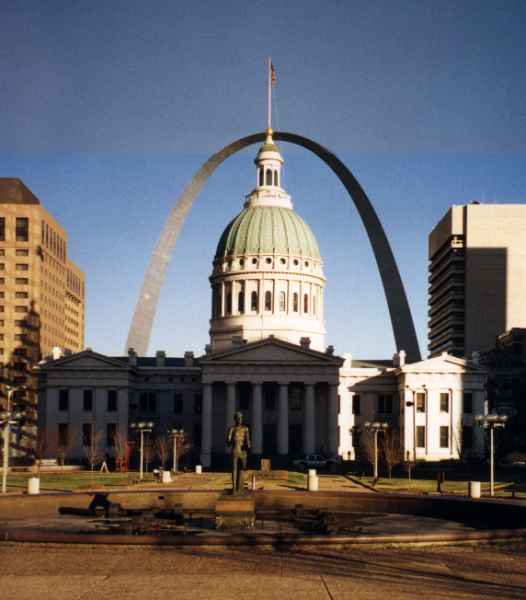 St. Louis, Missouri, my hometown, is the 18th largest city in the United States with a population of over 2.7 million people (as of 2004). It has a lovely mixture of Civil War history with nice statues to commemorate it, national monuments (um, the Arch), good Anheuser-Busch beer, baseball fanatisism, and a pretty decent arts and music scene, spanning from classical to modern to british rock (MUSE!) To top it off, it boasts well over 15 varied, heterogenous suburbs with their own share of history, monuments, beer, baseball, and culture.
St. Louis, Missouri, my hometown, is the 18th largest city in the United States with a population of over 2.7 million people (as of 2004). It has a lovely mixture of Civil War history with nice statues to commemorate it, national monuments (um, the Arch), good Anheuser-Busch beer, baseball fanatisism, and a pretty decent arts and music scene, spanning from classical to modern to british rock (MUSE!) To top it off, it boasts well over 15 varied, heterogenous suburbs with their own share of history, monuments, beer, baseball, and culture. Wake Forest, North Carolina, my family's new hometown, is far from well-known, large, or important. Here's a diagram to orient you:
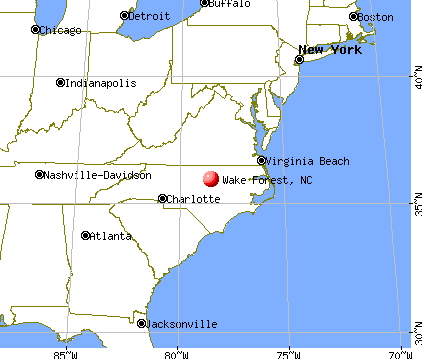
With a population of 20,000 and most of the houses hidden by sheets of skinny pine trees, it's sometimes difficult to even spot a house. It boasts three main roads: Capitol, Main Street, and Highway 401. The downtown is a hodgepodge of quaint tearooms, Southern antique stores, a Chevrolet museum, and a handful of restaurants.
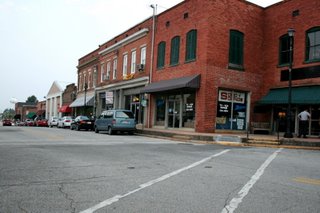

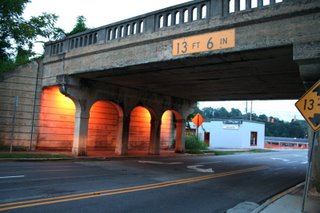
Downtown ----->
(top: view of corner downtown;
middle: shack and pretty tree
next to the bank downtown; bottom: cool bridge)
St. Louis houses over 30 Starbucks and a myriad of locally owned coffeehouses, not to metion Kaldi's, Kayak Coffee, and Cuppa Jo, to name a few. Wake Forest boasts 1 Starbucks (which is technically in northern Raleigh) and a suspicious "religious" coffehouse called "The Well" which provides "good fellowship" with each iced latte. It's good for quiet times but doesn't have the most exctiting atmosphere.
One of the biggest differences, as so astutely discoverd by Joseph S. Madden, is with the street names...which are normal, if not somewhat classy, in St. Louis. Washington Avenue, the Page Extension, Ladue Road, Creve Couer, Old Bonhomme, Clayton, and the like. Many names are French and don't allude to any specific object. Last names are of people are prevalent (I lived on Schulte Hill Drive, for example, whose namesake was an old patient of my mother's). Names here allude to natural objects and animals or are just plain odd. Gross, Bratt Street, Reindeer Moss, Stacked Stone, and Falls of Neuse Road among the butt of our STL guests' jokes.
And St. Louis food is...to...die...for. Home of the Gooey butter cake, Provel cheese, Imo's pizza, Ted Drewes Frozen Custard, Toasted Ravioli, Vess soda, and STL style barbeque, it also boasts Thai, Vietnamese, Chinese, Lebanese, Mexican, Brazilian, French, Italian, and Spanish cuisine. Wake Forest does boast a few good restaraunts, that are by no means eclectic or foreign but nonetheless solid. Twisted Forks, Milton's Pizza and Pasta, and Las Margaritas are among my personal favorites. Like any good ol' Southern town, it has plenty of Bojangles--home of sweet "tay" and and chicken biscuits.
I hope that over the next few weeks I will discover the history of Wake Forest along with little treasures of singularity here and there. The history is by no means stellar but is interesting, as I try to imagine what it would be like to grow up in the 10-year-old town before the Civil War. It was founded in 1820 by Dr. Calvin Jones. He advertised the community in the local paper as:
"One of the best neighborhoods in the state, the Forest District containing three schools and two well constructed and well filled meeting houses for Baptists and Methodists, and has a lawyer and a doctor. The inhabitants...are sober, moral and thriving in their circumstances, and not a few are educated and intelligent."
The town grew up around Wake Forest College, which relocated to Winston-Salem in 1956 (hence the confusion among my WS friends) and sold the campus to the Southeastern Baptist Theological Seminary.
Oh, and it also grew up around railroad tracks that are still here. I've had to stop for trains several times this summer.
I suppose I'll go to Raleigh more to regain a city flavor.
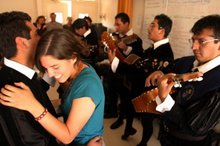

1 comment:
Good idea to dedicate a journal entry to describing your new town. It gives your readers some context.
It sounds like there's a lot of big-city attributes that you miss about Saint Louis. It must be a little big frustrating to down-size to a smaller town, but I'm sure there are joys to be discovered in slower-paced, Southern life. Sure it's less busy and less stimulating and less caffeine-driven, but maybe there's also a stronger sense of community to eventually tap into. I like that quote you have about the character of the neighborhood :)
Post a Comment